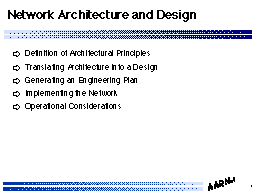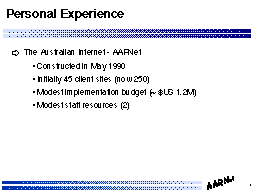 Introduction
IntroductionGeoff Huston, July 1994
Copyright (c) Geoff Huston, 1994
This presentation was written by Geoff Huston, who is the Network Technical Manager of the Australian Academic and Research Network (AARNet). He is one of the co-chairs of the IEPG, the Internet Service Operators' forum, and is a participant within the IETF community. He is also a member of the Board of Trustees of the Internet Society, and is currently the Secretary of the Society.
Geoff Huston Network Technical Manager Australian Academic and Research Network gih@aarnet.edu.au Ph: +61 6 249 3385 Fax: +61 6 249 1369
 Introduction
IntroductionThis presentation was formulated for the Internet Society's 1994 Workshop for Developing Countries, held in Prague, June 1994.
The topic covered is the architecture issues concerned with the development of national network infrastructures, focusing specifically on the issues involved with developing countries, the issues involved with the establishment of such infrastructure activity. The presentation looks at this from a perspective of the architecture of such systems.
There are a number of non-technical issues which touch on policy formulation at a national level which enable such activity. These are briefly summarised at the end of the presentation.
It is noted that this presentation is not intended to be a specific "cookbook" for the design and implementation of a national Internet network service - this presentation will cover various aspects of this task in very general terms. In this task there is no universal "right" or "wrong" way to undertake such activity. The following are very much views derived from the personal experience of constructing a national network infrastructure within Australia over the period from 1989 until 1994, and the associated experience of working with the Internet environment globally over this same period. It is readily acknowledged that whatever attempts at "guidelines" that are proposed within this presentation will, necessarily, be extensively modified within the practical environment of a particular nation or region, and accordingly the author cautions any reader to view the following more as a set of personal observations rather than a more substantive set of objective and rigid principles.
 Internet Service Architecture and Design
Internet Service Architecture and Design
- Definition of Architectural Principles
- Translating Architecture into a Design
- Generating an Engineering Plan
- Implementing the Network
- Operational Considerations
- Policy Considerations
This presentation will treat the subject area within six broad areas:
 Personal Experience
Personal Experience
- The Australian Internet - AARNet
Constructed in May 1990
Initially 45 client sites (now 250)
Modest implementation budget (~ $US 1.2M)
Modest staff resources (2)
To provide some insight as to the perspective of the author within the scope of this presentation, the author's background is that of the architect, engineering manager and overall project manager of the implementation of the Australian Academic and Research Network in Australia, the major Internet Service Provider within Australia (the entire operation was staffed with a single employee (the author) for the first year, so there was little choice but to assume all potential roles for the period!)
The network project commenced in 1989, and following some 14 months of effort, principally concerned with creating a policy and consequential funding structure for the network, the network was commissioned in May 1990.
The initial rollout of the network was a direct client site service to some 25 university sites, distributed across Australia, and the total budget for the first year of operation was some $US 1.2M.
The network has grown over the intervening period to currently service some 800 Australian organisations, and now operates megabit capacity links both domestically and internationally to service this national Internet community.
The network effort has always been one with a small core of staff - from the initial complement of 1, for the next three years the total staffing complement was 2. This has grown lately to 6 staff members, but compared to the level of business growth, the network organisation remains a small, and by necessity, tightly focused operation.
3. Engineering the Network - The Client Interface
4. Engineering the Network - External Peering
5. Engineering the Network - Infrastructure
7. The Operational Environment
GH, July 1994